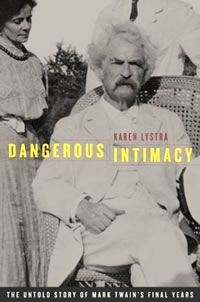

Newly Found Mark Twain Letter Accuses Business Aide of Theft
By GEORGE GENT
The New York Library announced yesterday the acquisition of a hitherto unknown manuscript by Mark Twain, possibly the last he ever wrote, in which he related how he had allegedly been swindled by a young Englishman and his female secretary.
The 400-page manuscript, which is in the form of a letter written in the fall of 1909 to William Dean Howells, the novelist, was acquired by the library's Berg Collection of English and American literature for a sum in excess of $25,000. The letter had been found in a shoebox among the papers of a long-time business associate of Edward E. Loomis, whose wife, Julia Langdon, was a niece of Mark Twain's wife.
Apparently, Mrs. Loomis gave the manuscript to the associate, Harold R. German, for safekeeping. It was Mr. German's daughter who found the manuscript and offered it for the sale through a dealer.
Dr. Lola L. Szladits, curator of the Berg Collection, which plans to exhibit the manuscript at a later date, said of the purchase:
"It seems highly unlikely that another Mark Twain manuscript of this importance will come to light again, and its acquisition by the Berg Collection carries out the wish of the author."
In the letter to Mr. Howells, which apparently was never actually sent, Twain tells about the alleged thefts of thousands of dollars by Ralph W. Ashcroft, an Englishman, and his secretary of five years, Isabel Lyon.
Although the terms of the sale do not permit quotations from the manuscript, Dr. Szladits said yesterday that the alleged pilfering included, in part, "withholding of part of the salaries of servants in the Twain household of Stormfield in Redding, Conn., where the author lived with his daughter, Clara Clemens."
Twain had engaged young Ashcroft as his business manager in 1907, when the American author was awarded an honorary degree by Oxford University. Later, together with Miss Lyon, who had authority to sign checks for the author, they were suspected of theft.
In what appeared unseemly haste to the aging author, Mr. Ashcroft and Miss Lyon were married and, shortly after Twain had filed suit against them, they left for England, allegedly to avoid having to testify against each other.
In 1909, The New York Times published a story that said "the differences (between the litigants) ... have been settled without an appeal to the courts." However, in a nine-page letter attached to the manuscript, Twain wrote to Adolph S. Ochs, publisher of The Times, rejecting the veracity of the news account and accusing the paper of falsehoods. At the time, Twain failed to elaborate on the situation, declaring the matter to be a private one.
In his letter to Mr. Howells, Twain is outspoken about his gullibility in the affair and in his introduction added a typical letter to posterity, exhorting the person who might one day find the manuscript to preserve it for the value of its contents.
The incident is mentioned in several of Twain's biographies. Albert Bigelow Paine, the official biographer and personal friend of the author, mentioned it briefly in "Mark Twain - A Biography." Justin Kaplan, in his "Mr. Clemens and Mark Twain," published in 1966, describes the episode and the personalities involved, which brought on "a horrible denouement and which Mr. Paine was sure undermined Clemens's health."
About six months after Twain had finished his account of the story, the only full report to survive, he died in 1910 at the age of 75. Mr. Ashcroft, who later became Toronto manager of the Canadian Advertising Agency, died in that city in 1947 at the age of 72.
|
Related resource: Karen Lystra's DANGEROUS INTIMACY (University of California Press, 2004). |
 available from amazon.com |
Return to The New York Times
index

Quotations | Newspaper Articles | Special Features | Links
| Search